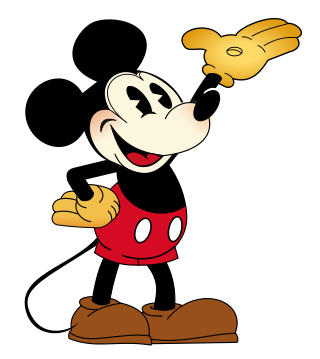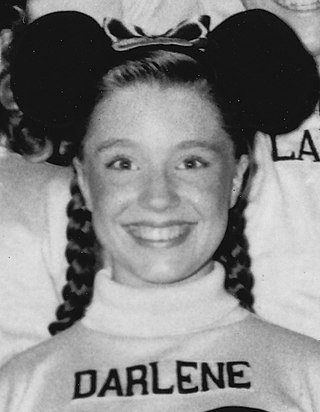
The Mickey Mouse Club is an American variety television show that aired intermittently from 1955 to 1996 and briefly returned to social media in 2017. Created by Walt Disney and produced by Walt Disney Productions, the program was first televised for four seasons, from 1955 to 1959, by ABC. This original run featured a regular, but ever-changing cast of mostly teen performers. ABC broadcast reruns weekday afternoons during the 1958–1959 season, airing right after American Bandstand. The show was revived three times after its initial 1955–1959 run on ABC, first from 1977 to 1979 for first-run syndication as The New Mickey Mouse Club, then from 1989 to 1996 as The All-New Mickey Mouse Club airing on The Disney Channel, and again from 2017 to 2018 with the moniker Club Mickey Mouse airing on internet social media.

Mickey Mouse is an American cartoon character co-created in 1928 by Walt Disney and Ub Iwerks. The longtime icon and mascot of the Walt Disney Company, Mickey is an anthropomorphic mouse who typically wears red shorts, large shoes, and white gloves. He is often depicted alongside his girlfriend Minnie Mouse, his pet dog Pluto, his friends Donald Duck and Goofy, and his nemesis Pete.

Lawrence Welk was an American accordionist, bandleader, and television impresario, who hosted The Lawrence Welk Show from 1951 to 1982. The program was known for its light and family-friendly style, and the easy listening music featured became known as "champagne music" to his radio, television, and live-performance audiences.

Annette Joanne Funicello was an American actress and singer. She began her professional career at age 12, becoming one of the most popular Mouseketeers on the original Mickey Mouse Club. In her teenage years, Funicello had a successful career as a pop singer recording under the name "Annette". Her most notable singles are "O Dio Mio", "First Name Initial", "Tall Paul", and "Pineapple Princess". During the mid-1960s, she established herself as a film actress, popularizing the successful "Beach Party" genre alongside co-star Frankie Avalon.

The Lawrence Welk Show is an American televised musical variety show hosted by big band leader Lawrence Welk. The series aired locally in Los Angeles for four years, from 1951 to 1955, then nationally for another 16 years on ABC from 1955 to 1971, followed by 11 years in first-run syndication from 1971 to 1982. Repeat episodes are broadcast in the United States by PBS stations. These airings incorporate an original program — usually, a color broadcast from 1965 to 1982 — in its entirety. In place of the commercials, newer performance and interview clips from the original stars and/or a family member of the performers are included; these clips are occasionally updated.

Myron Floren was an American musician best known as the accordionist on The Lawrence Welk Show between 1950 and 1980. Floren came to prominence primarily from his regular appearances on the weekly television series in which Lawrence Welk dubbed him as "the happy Norwegian," which was also attributed to Peter Friello.

James Wesley Dodd was an American actor, singer and songwriter best known as the master of ceremonies for the popular 1950s Walt Disney television series The Mickey Mouse Club, as well as the writer of its well-known theme song "The Mickey Mouse Club March." A different version of this march, much slower in tempo and with different lyrics, became the alma mater that closed each episode.

Sharyn Eileen "Sherry" Alberoni is a former American child actress. She got her start as a Mouseketeer on the weekday ABC television program The Mickey Mouse Club. As an adult, Alberoni became a voice artist for Hanna-Barbera Productions. Besides providing voices for numerous incidental characters in series such as Jeannie, Alberoni is best known as the voice of nasty rich-girl Alexandra Cabot from Josie and the Pussycats; "superhero-in-training" Wendy from the first season of Super Friends; the heroic robot Bo in Mighty Orbots; and Glumdalclitch in The Three Worlds of Gulliver. In 1971, she starred alongside Patty Andrews in the Sherman Brothers stage musical, Victory Canteen.

Karen Anita Pendleton was an original Mickey Mouse Club Mouseketeer on the ABC television series from 1955 to 1959. She was one of only nine Mouseketeers who were on the show during its entire original run.

Cissy King is an American-born singer and dancer best known as a featured performer on The Lawrence Welk Show television program.

Darlene Gillespie is a Canadian-American former child actress, most remembered as a singer and dancer on the original The Mickey Mouse Club television series from 1955 to 1959. After her career in entertainment ended, she became a nurse.

Doreen Isabelle Tracey was a British-born American performer who appeared on the original Mickey Mouse Club television show from 1955 to 1959.
"Calcutta" is a German pop song. An instrumental version by American bandleader and TV host Lawrence Welk on the 1961 Dot Records album Calcutta! was a Number One song in the United States, and the most successful hit of Welk's career.

The Karnival Kid is a 1929 Mickey Mouse short animated film released by Celebrity Productions, as part of the Mickey Mouse film series. It was directed by Walt Disney and animated by Ub Iwerks with music by Carl W. Stalling. It was the ninth Mickey Mouse short to be produced; the sixth of that year.
Barbara Boylan is an American dancer and former television personality who was featured on The Lawrence Welk Show from 1961 to 1967, and briefly for a few months in 1979.
Lonnie Burr is an American actor, entertainer and writer best known as one of nine of the original thirty-nine Mouseketeers who remained under a seven-year contract for the complete filming (1955–1959) of Walt Disney’s children’s television show the Mickey Mouse Club. The Mickey Mouse Club was the first national TV show to star children who appeared primarily as themselves as well as acting as characters in scenes and musical numbers. The original show aired in syndication in the 1960s, reran again in 1975, then on the Disney Channel in the 1980s through the early 2000s.
The fourth wave of Walt Disney Treasures was released December 7, 2004. This is the only wave that comes in White cases, and is the final wave that is in double DVD cases. Starting with this wave, the side strap was replaced with seal wrap with stickers and the back was no longer printed on the tin but included as a card glued to the back.

Carl Patrick "Cubby" O'Brien, better known by his nickname Cubby, is an American drummer and former child actor. He is known as one of the original Mouseketeers on the weekday ABC television program The Mickey Mouse Club from 1955 to 1958.
Roy Williams was an artist and entertainer for The Walt Disney Studios, best known as "Big Roy," the adult mouseketeer for four seasons on the Mickey Mouse Club television series and for his invention of the Mickey Mouse hats.
Mickey's 90th Spectacular is a two-hour television special broadcast on ABC on November 4, 2018. It celebrates the 90th anniversary of the debut of Walt Disney's animated character Mickey Mouse.











